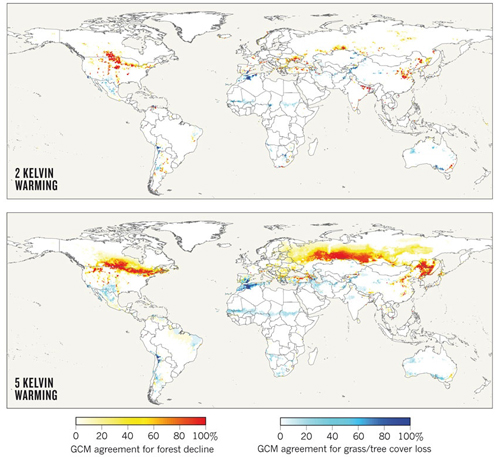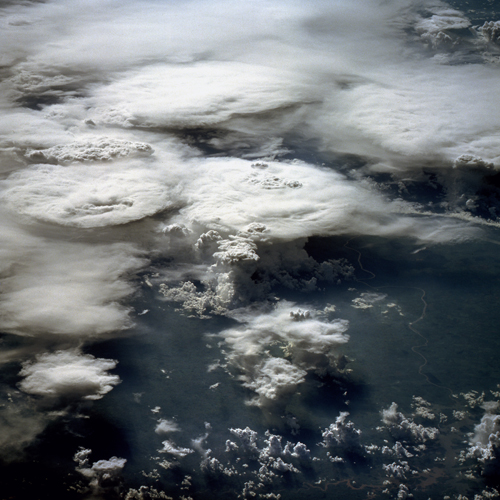Microbes may be small, but they shouldn’t be ignored when considering global climate. According to a new colloquium report from The American Academy of Microbiology, microbes such as bacteria, algae, and fungi play a powerful role in the Earth’s climate. “Incorporating Microbial Processes into Climate Models” notes how the impact of microbes on the atmosphere goes way back in time. The critical mix of carbon dioxide and oxygen we take for granted as sustaining life on the planet is due to the rise of these tiny creatures eons ago.
So what specifically do these minute forms of life have to do with climate today? According to the report, the answer is plenty. “The sum total of their activity is enormous. But of course not all microbes are the same—some of them are producing oxygen, others are consuming it. Some are taking carbon dioxide out of the air, others are adding it.”
The big questions that the report asks and plans to address by incorporating microbial processes into climate change models: what’s the overall effect of microbial activities on the concentration of carbon dioxide in the atmosphere? Is it possible this activity will absorb the carbon dioxide being added to the atmosphere? Or will the rising global temperature might spur microbes to produce even more carbon dioxide?
The authors recognize that the gap between the climatology and microbiology is large, but they say it is not insurmountable. Some of the same technologies used to collect data for climate models—satellite imaging of cloud cover and precipitation, submarine cables that monitor changes in temperature and salinity, sensors to retrieve real-time data from remote locations—can also be applied to measuring biological phenomena. Collaboration between the sciences, they believe, will benefit both fields.
A more detailed look at the report is available here.
climate
Upping the Ante on Modeling Climate Change Impacts
There is a growing urgency to produce global projections of how a warming climate could affect life on Earth.
“Impact research is lagging behind physical climate sciences,” says Pavel Kabat, director of the International Institute for Applied Systems Analysis (IIASA) in Austria. “Impact models have never been global, and their output is often sketchy. It is a matter of responsibility to society that we do better.”
Time is running out for researchers hoping to contribute impact simulations to the IPCC’s Fifth Assessment Report (scheduled for publication in 2014). So last month, the IIASA and the Potsdam Institute for Climate Impact Research (PIK) started a project to compare climate-impact models collected from more than two dozen research groups in eight countries. The Inter-Sectoral Impact Model Intercomparison Project (ISI-MIP) will integrate climate data from state-of-the-art models, using a range of greenhouse-gas emission scenarios (models used in the project can be found here). Because the various emissions scenarios result in a range of projected global temperature increases, potential impacts also can vary widely across a range of scenarios. It is hoped that the project will clarify systematic biases that can cause models to produce disparate results.
The models will investigate the effects of climate change on global agriculture, water supplies, vegetation, and health. Results are due by July 1, and reports on each of the four impact areas are scheduled to be completed by January of 2013. This means the data could be available for the IPCC’s next report–which “will make a real difference for the assessment process,” notes Chris Field of the Carnegie Institution for Science, cochair of IPCC Working Group II. “I greatly appreciate the initiative required to get this activity underway, and I appreciate the commitment to fast-track components that will yield results in time for inclusion in the IPCC Fifth Assessment Report.”
The ISI-MIP is scheduled to continue into 2013 and could be expanded to analyze climatic impacts on transport and energy infrastructures.

Disaster Risk Management Meets Climate Change Adaptation
by William Hooke, AMS Policy Program Director, from the AMS project, Living on the Real World
An increasingly popular and visible feature of AMS Annual Meetings is a suite of so-called Town Halls. Often scheduled for the lunch hour (and therefore attracting primarily that minority of attendees who prefer food for thought to the competing invitation of physical sustenance with friends), these sessions are supposed to model the iconic town halls that once were the heart of the new England political process. They’re more about community input than any erudition of the speakers.
I was a last-minute substitute panelist, for the panel on Risk Mitigation for Climate Adaptation and Natural Hazards. The session took its cue from a recently-released Summary for Policymakers of an IPCC Special Report on Managing the Risks of Extreme Events and Disasters to Advance Climate Change Adaptation (SREX).
For those in the field, this special report has been required reading. Thirty pages or so of thoughtful, well-reviewed and well-documented material. [We can look forward to publication of the full document next month.] Here’s the bit that to me looks salient today: “Closer integration of disaster risk management and climate change adaptation, along with the incorporation of both into local, subnational, national, and international development policies and practices, could provide benefits at all scales.” [page 9]
The idea, in a nutshell, is that disaster risk management and climate change adaptation share much in common. The Town Hall announcement highlights the difference this way: risk management draws from history, while climate change looks to the future. The idea is the incorporating this forward-looking perspective into more traditional hazard risk management will lead to more resilient communities.
This is a great thought…but also maybe a no-brainer.
On reflection, this session also provides opportunity to reflect anew on five ways (there are undoubtedly others) we might make hazard risk management itself (and by implication, climate adaptation) more effective.
Embrace No-Adverse-Impact policies. Environmental impact statements have been with us a long time. You know the idea. When you and I contemplate construction, land use, etc., we have to assess the environmental consequences of our actions. In a similar way, we could and should assess the benefits and/or risks our plans and actions imply for community resilience.
Learn from experience. When it comes with natural hazard rsik management, we should adopt the learn-from-experience habits of aviation, as embodied in the work of the National Transportations Safety Board.
Measure progress. Hazard loss figures are noisy year-to-year and uncertain. But the discipline of continually honing our ability to estimate losses will in itself contribute to the awareness needed to motivate loss reduction when averaged over years.
Foster public-private collaboration. Such collaborations are not optional in today’s free-market societies. However, there’s considerable room for improving the level of such collaborations. They should not be fragmented, haphazard, merely tactical. They should instead be truly collaborative, ongoing, strategic.
Revitalize a venerable institution. Much has been made recently about a notional move of NOAA from the Department of Commerce into the Department of Interior. Dr. Lubchenco was questioned on this in her talk of yesterday. With NOAA embedded in Commerce, a good case can be made that the Department of Commerce provides an excellent home for achieving these several goals of hazard risk reduction and climate adaptation. However, this potential has been recognized and ignored for decades. If it’s never to be realized, then a move to Interior makes more sense.
A Good Climate for Looking at Clouds
How much do we know about clouds and the effects they have on climate change? It’s a lingering source of uncertainty, with as many questions as answers. No wonder the National Science Foundation calls them “The Wild Card of Climate Change” on its new website about the effect of clouds in climate.
The site is good place to start thinking about this complicated issue. The NSF page features videos of cloud experts like David Randall of Colorado State University and AMS President Peggy LeMone of NCAR, as well as a slide show, animations, articles, and other educational material that address some of most salient cloud/climate questions, such as: Will clouds help speed or slow climate change? Why is cloud behavior so difficult to predict? And how are scientists learning to project the behavior of clouds?
The impression one gets from the website about the progress of the science in this area may vary depending on your point of view, but Randall, for one, sounds about as optimistic as you can get. In his video, he admits that optimism is a job requirement for climate modelers, but in his assessment, “We’re not in the infant stages of understanding [clouds] any more; we’re in first or second grade, and on the way to adolescence.” His hope for solving their role in climate and representing cloud effects in climate modeling rests in part on better computers and in part on the numerous bright people entering the field now, ready to overshadow the work of their mentors.
The AMS Annual Meeting in Seattle will be a good occasion to dig deeper at the roots of Randall’s optimism and sample some of the emerging solutions to the cloud/climate relationship. For example, Andrei Sokolov and Erwan Monier of MIT will discuss the influence that adjusting cloud feedback has on climate sensitivity (Wednesday, 26 January, 11:30 a.m. in Climate Variability and Change). Basically, they’re using small adjustments to the cloud cover used to calculate surface radiation in a model to create a suite of results–an ensemble. The range of results better reflects the sensitivity of climate observed in the 20th century better than some other methods of creating ensembles, such as adjusting the model physics.
Randall says in his video that early predictions about climate change are already coming to pass and this leads to optimism that more predictions will verify well in the coming years as we scrutinize climate more and more closely. This of course presupposes sustained efforts to observe and verify. Laying the groundwork for this task–and for thus better climate models–are Stuart Evans (University of Washington) and colleagues in a study they are presenting in Seattle. According to their abstract, “Improving cloud parameterizations in large scale models hinges on understanding the statistical connection between large scale dynamics and the cloud fields they produce.” Their study focuses on the relationship between synoptic-scale dynamic patterns and cloud properties (Monday, 24 January, 11 a.m. in Climate Variability and Change). Evans et al. dig through 13 years of cloud vertical radar profiles from the US Southern Plains site of the DOE ARM program and relate it to atmospheric “states”, thus providing a metric for evaluating how well climate models relate cloudiness to radiation and other surface properties.
While Evans and colleagues use upward looking remote sensing, Joao Teixeira (JPL/Cal Tech) and coauthors look down at boundary layer cloudiness from above–using satellites. They expect to show how new methodologies with satellite data can improve the way low level clouds are parameterized in climate models (Thursday, 27 January, 9:30 a.m., in Climate Variability and Change). A recent workshop at Cal Tech on space-based studies of this problem stated:
Clouds in the boundary layer, the lowermost region of the atmosphere adjacent to the Earth’s surface, are known to play the key role in climate feedbacks that lead to these large uncertainties. Yet current climate models remain far from realistically representing the cloudy boundary layer, as they are limited by the inability to adequately represent the small-scale physical processes associated with turbulence, convection and clouds.
The lack of realism of the models at this low level is compounded by the lack of global observing of what goes on underneath the critical low-level cloud cover–hence the effort of Teixeira et al. (and others) to “leverage” satellite observing, with its global reach, to improve understanding of low level thermodynamics in the name of improving climate simulations.
